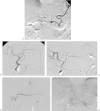Multiple arteries supplying a single tumor vascular distribution: microsphere administration options for the interventional radiologist performing radioembolization
- PMID: 25049448
- PMCID: PMC4078137
- DOI: 10.1055/s-0034-1373794
Multiple arteries supplying a single tumor vascular distribution: microsphere administration options for the interventional radiologist performing radioembolization
Figures


References
-
- Furuta T, Maeda E, Akai H. et al.Hepatic segments and vasculature: projecting CT anatomy onto angiograms. Radiographics. 2009;29(7):1–22. - PubMed
-
- Bilbao J I, Garrastachu P, Herráiz M J. et al.Safety and efficacy assessment of flow redistribution by occlusion of intrahepatic vessels prior to radioembolization in the treatment of liver tumors. Cardiovasc Intervent Radiol. 2010;33(3):523–531. - PubMed
-
- Uliel L, Royal H D, Darcy M D, Zuckerman D A, Sharma A, Saad N E. From the angio suite to the γ-camera: vascular mapping and 99mTc-MAA hepatic perfusion imaging before liver radioembolization—a comprehensive pictorial review. J Nucl Med. 2012;53(11):1736–1747. - PubMed
-
- Abdelmaksoud M H Louie J D Kothary N et al.Consolidation of hepatic arterial inflow by embolization of variant hepatic arteries in preparation for yttrium-90 radioembolization J Vasc Interv Radiol 201122101364–1371., e1 - PubMed
-
- Paprottka P M, Jakobs T F, Reiser M F, Hoffmann R T. Practical vascular anatomy in the preparation of radioembolization. Cardiovasc Intervent Radiol. 2012;35(3):454–462. - PubMed
Publication types
LinkOut - more resources
Full Text Sources
Other Literature Sources

